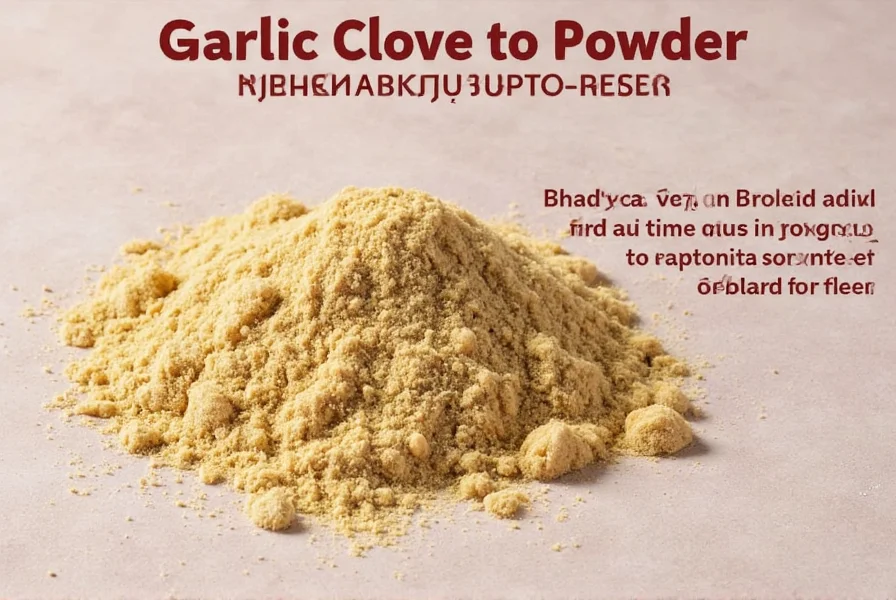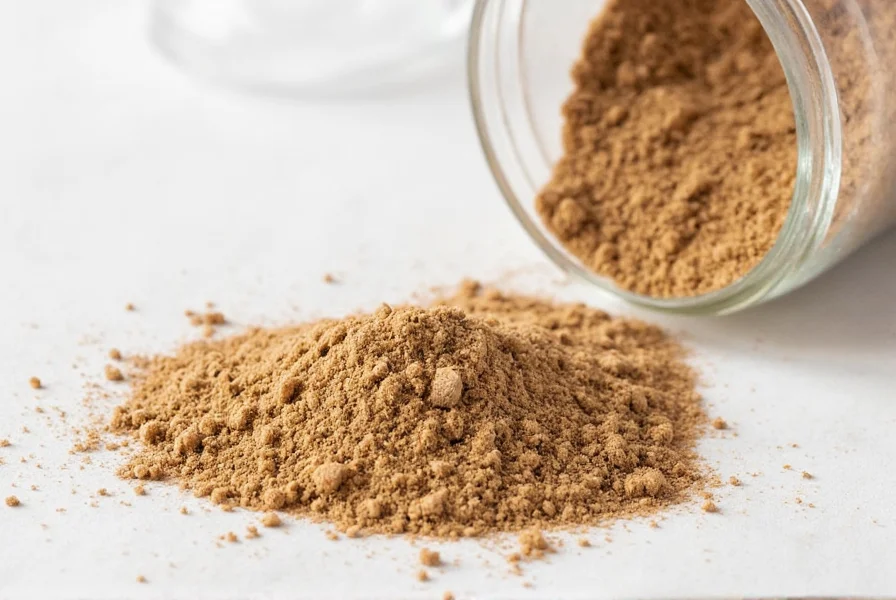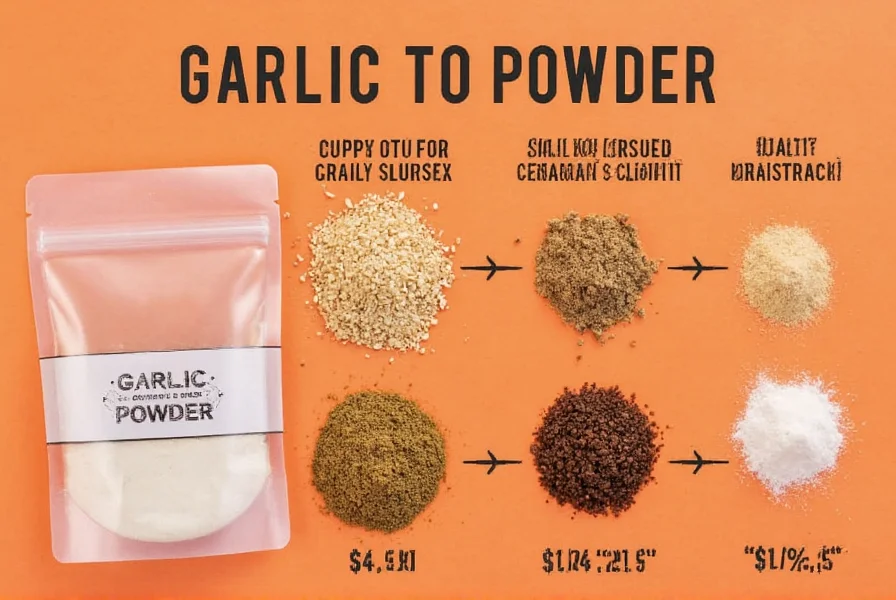Understanding garlic measurements can transform your cooking experience. Many home chefs struggle with converting fresh garlic cloves to garlic powder, leading to inconsistent results in their recipes. This comprehensive guide provides precise measurements, practical conversion techniques, and professional cooking insights to help you master garlic usage in any kitchen application.
Understanding Garlic Conversions
Garlic exists in multiple forms, each with distinct flavor profiles and measurement requirements. The conversion between fresh garlic cloves and garlic powder isn't merely about volume—it involves understanding flavor concentration and culinary chemistry.
| Garlic Form | Equivalent Measurement | Flavor Intensity |
|---|---|---|
| 1 medium fresh garlic clove | ⅛ teaspoon garlic powder | Moderate |
| 1 large fresh garlic clove | ⅔ teaspoon garlic powder | Moderate |
| 1 teaspoon fresh minced garlic | ¼ teaspoon garlic powder | Moderate |
| 1 tablespoon fresh minced garlic | ¾ teaspoon garlic powder | Moderate |
Why Garlic Conversions Matter
Garlic powder contains approximately three times the flavor concentration of fresh garlic due to the dehydration process. When you're converting garlic clove to powder measurements incorrectly, you risk either under-seasoning your dishes or creating overpowering, bitter flavors. Professional chefs emphasize that understanding these garlic powder measurement equivalents prevents common cooking mistakes that ruin otherwise perfect recipes.
Making Garlic Powder at Home
Creating your own garlic powder preserves maximum flavor and avoids additives found in commercial products. Follow these steps for superior homemade garlic powder:
- Select fresh, firm garlic bulbs with no signs of sprouting
- Peel and thinly slice cloves (1/8 inch thick)
- Dehydrate at 140°F (60°C) for 6-8 hours until completely brittle
- Grind in a spice grinder until fine powder forms
- Store in an airtight container away from light and moisture

Garlic Powder vs Fresh Garlic: Culinary Applications
Each form of garlic serves different culinary purposes. Fresh garlic provides a bright, pungent flavor that works best when added late in cooking or used raw. Garlic powder offers consistent flavor distribution and works well in dry rubs, spice blends, and dishes requiring long cooking times.
When substituting garlic powder for fresh garlic in recipes, remember that the powder dissolves completely while fresh garlic maintains texture. This affects both flavor release and mouthfeel in your finished dish. For marinades and dressings, fresh garlic provides better emulsification properties, while garlic powder works superiorly in dry spice mixes.
Accurate Substitution Guide
Successful recipe adaptation requires understanding both volume and flavor conversion. Use this practical substitution framework:
- Dry rubs and spice blends: Use 100% garlic powder substitution (1/8 tsp powder per clove)
- Slow-cooked dishes: Use 75% of the powder equivalent (3/32 tsp per clove)
- Raw applications (dressings, dips): Avoid powder substitution when possible
- Baking applications: Use 50% of powder equivalent (1/16 tsp per clove)
When converting from powder to fresh garlic, multiply the powder measurement by 8 for medium cloves or by 6 for large cloves. Always adjust based on your specific garlic variety and personal taste preferences.
Storage and Shelf Life
Proper storage significantly impacts garlic quality. Fresh garlic cloves stored in a cool, dark place maintain quality for 3-6 months. Once peeled, use within 1 week. Garlic powder retains optimal flavor for 6-12 months when stored in an airtight container away from light and moisture.
Never store fresh garlic in the refrigerator, as this promotes sprouting and mold growth. For long-term storage, freeze peeled cloves in an airtight container for up to 12 months. Garlic powder loses potency gradually, so check for strong aroma before using in critical recipes.

Nutritional Comparison
While both forms provide health benefits, fresh garlic contains higher levels of allicin, the compound responsible for many of garlic's health properties. The dehydration process reduces but doesn't eliminate these beneficial compounds. Commercial garlic powder sometimes contains anti-caking agents, so check labels if you have dietary restrictions.
One teaspoon of garlic powder contains approximately 10 calories, 2.3g carbohydrates, and 0.4g protein. A single medium garlic clove contains about 4 calories, 1g carbohydrates, and 0.2g protein. The concentration effect means you typically use less powder than fresh garlic, balancing the nutritional differences in actual usage.
Professional Chef Tips
Top culinary professionals recommend these garlic usage techniques:
- Toast garlic powder briefly in dry pan before use to enhance flavor complexity
- Reconstitute garlic powder with a few drops of water when substituting for fresh
- Combine both fresh and powder forms in layered recipes for depth of flavor
- Add garlic powder early in cooking for infused flavor, fresh garlic near the end for punch
Frequently Asked Questions
How many garlic cloves equal 1 teaspoon of garlic powder?
Eight medium garlic cloves equal approximately 1 teaspoon of garlic powder. This garlic clove to powder conversion accounts for the dehydration process that concentrates the flavor and reduces volume.
Can I substitute garlic powder for fresh garlic in all recipes?
While you can substitute garlic powder for fresh garlic in most cooked dishes, it doesn't work well in raw applications like salad dressings or aioli. For best results, use 1/8 teaspoon garlic powder per medium garlic clove in cooked recipes, but stick with fresh garlic for uncooked preparations.
Why does my garlic powder substitution taste too strong?
Garlic powder contains concentrated flavor compounds, so using too much creates overpowering results. Remember the garlic powder measurement equivalent: 1 clove = 1/8 teaspoon powder. If your substitution tastes too strong, you've likely used more powder than the proper conversion ratio.
How do I make garlic powder from fresh cloves at home?
To make homemade garlic powder, thinly slice peeled cloves, dehydrate at 140°F until brittle (6-8 hours), then grind to a fine powder. Store in an airtight container. This fresh garlic to garlic powder process preserves maximum flavor without additives found in commercial products.
Does garlic powder have the same health benefits as fresh garlic?
Garlic powder retains many health benefits but contains lower levels of allicin, the primary active compound. Fresh garlic produces allicin when crushed, while powder has already undergone this chemical reaction during processing. Both forms offer cardiovascular and immune system benefits, though fresh garlic generally provides higher concentrations of beneficial compounds.











 浙公网安备
33010002000092号
浙公网安备
33010002000092号 浙B2-20120091-4
浙B2-20120091-4